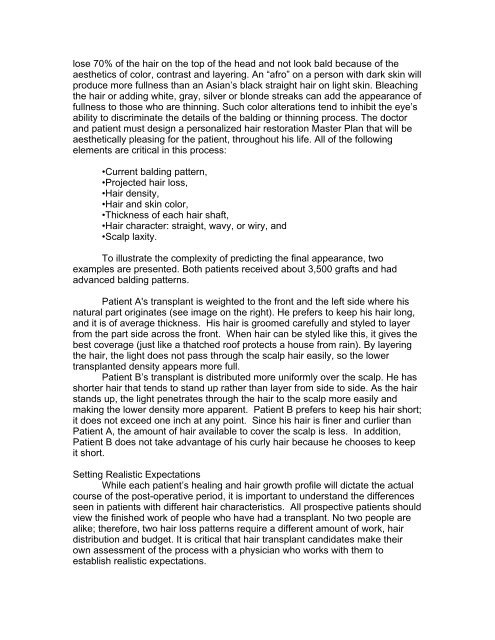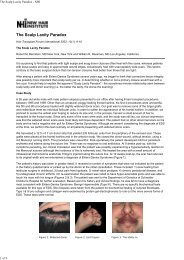The Patient's Guide to Hair Restoration - New Hair Institute
The Patient's Guide to Hair Restoration - New Hair Institute
The Patient's Guide to Hair Restoration - New Hair Institute
Create successful ePaper yourself
Turn your PDF publications into a flip-book with our unique Google optimized e-Paper software.
lose 70% of the hair on the <strong>to</strong>p of the head and not look bald because of the<br />
aesthetics of color, contrast and layering. An “afro” on a person with dark skin will<br />
produce more fullness than an Asian’s black straight hair on light skin. Bleaching<br />
the hair or adding white, gray, silver or blonde streaks can add the appearance of<br />
fullness <strong>to</strong> those who are thinning. Such color alterations tend <strong>to</strong> inhibit the eye’s<br />
ability <strong>to</strong> discriminate the details of the balding or thinning process. <strong>The</strong> doc<strong>to</strong>r<br />
and patient must design a personalized hair res<strong>to</strong>ration Master Plan that will be<br />
aesthetically pleasing for the patient, throughout his life. All of the following<br />
elements are critical in this process:<br />
•Current balding pattern,<br />
•Projected hair loss,<br />
•<strong>Hair</strong> density,<br />
•<strong>Hair</strong> and skin color,<br />
•Thickness of each hair shaft,<br />
•<strong>Hair</strong> character: straight, wavy, or wiry, and<br />
•Scalp laxity.<br />
To illustrate the complexity of predicting the final appearance, two<br />
examples are presented. Both patients received about 3,500 grafts and had<br />
advanced balding patterns.<br />
Patient A's transplant is weighted <strong>to</strong> the front and the left side where his<br />
natural part originates (see image on the right). He prefers <strong>to</strong> keep his hair long,<br />
and it is of average thickness. His hair is groomed carefully and styled <strong>to</strong> layer<br />
from the part side across the front. When hair can be styled like this, it gives the<br />
best coverage (just like a thatched roof protects a house from rain). By layering<br />
the hair, the light does not pass through the scalp hair easily, so the lower<br />
transplanted density appears more full.<br />
Patient B’s transplant is distributed more uniformly over the scalp. He has<br />
shorter hair that tends <strong>to</strong> stand up rather than layer from side <strong>to</strong> side. As the hair<br />
stands up, the light penetrates through the hair <strong>to</strong> the scalp more easily and<br />
making the lower density more apparent. Patient B prefers <strong>to</strong> keep his hair short;<br />
it does not exceed one inch at any point. Since his hair is finer and curlier than<br />
Patient A, the amount of hair available <strong>to</strong> cover the scalp is less. In addition,<br />
Patient B does not take advantage of his curly hair because he chooses <strong>to</strong> keep<br />
it short.<br />
Setting Realistic Expectations<br />
While each patient’s healing and hair growth profile will dictate the actual<br />
course of the post-operative period, it is important <strong>to</strong> understand the differences<br />
seen in patients with different hair characteristics. All prospective patients should<br />
view the finished work of people who have had a transplant. No two people are<br />
alike; therefore, two hair loss patterns require a different amount of work, hair<br />
distribution and budget. It is critical that hair transplant candidates make their<br />
own assessment of the process with a physician who works with them <strong>to</strong><br />
establish realistic expectations.



